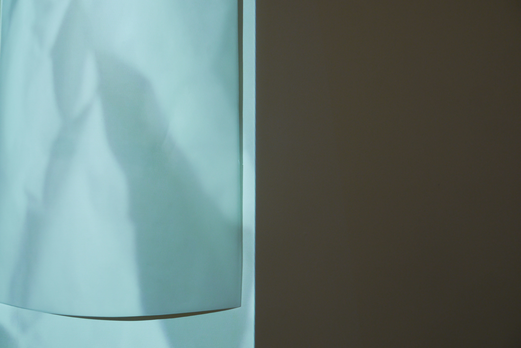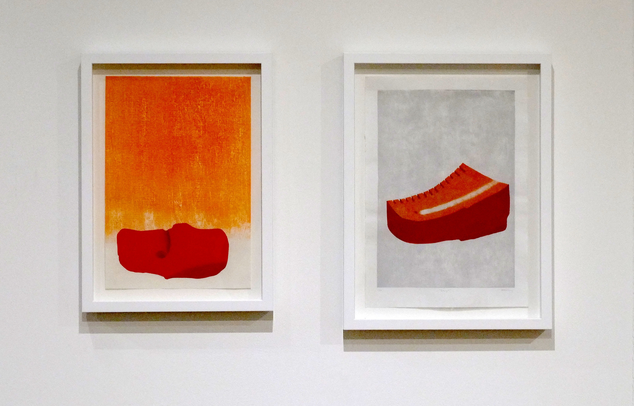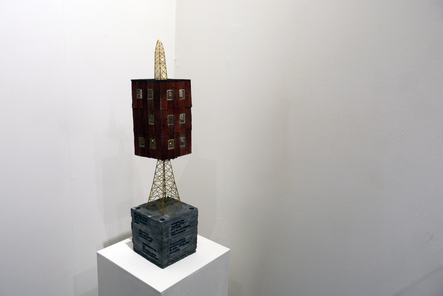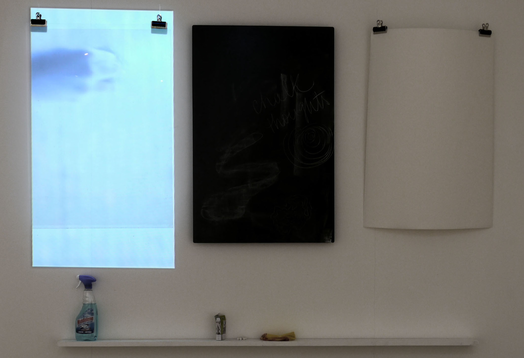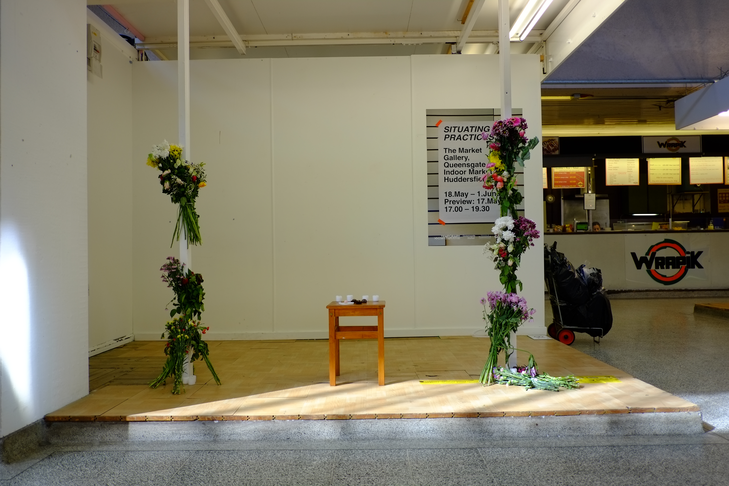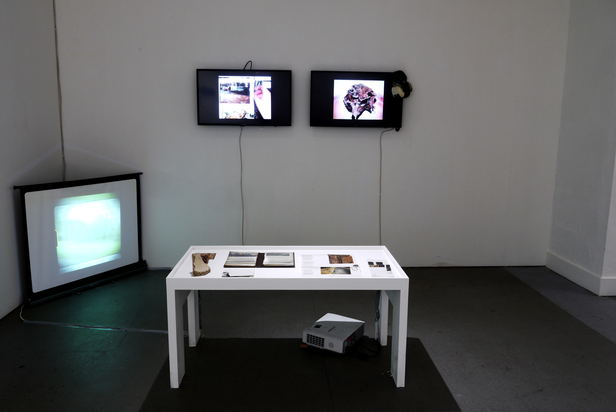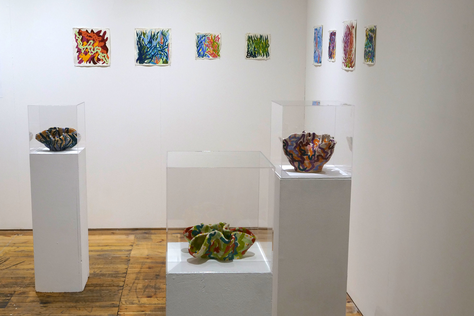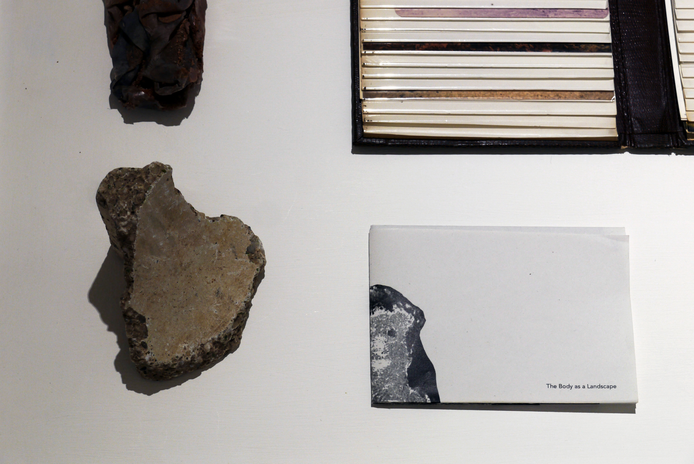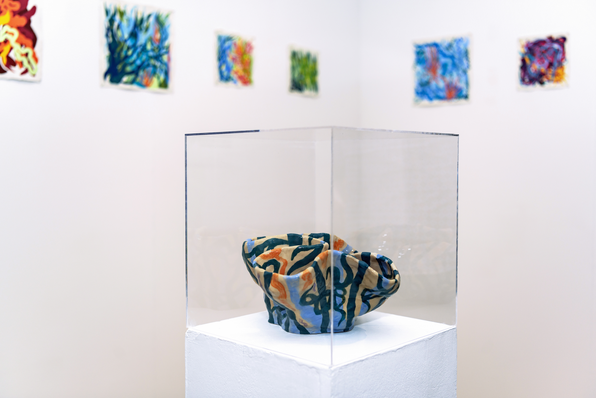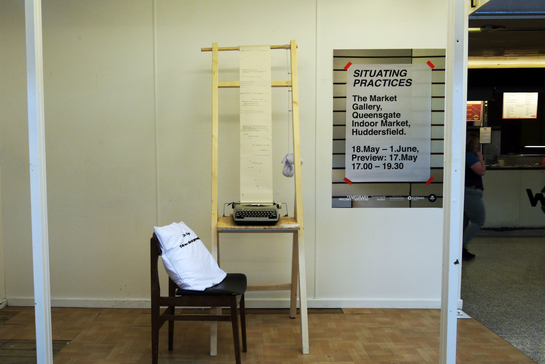SITUATING PRACTICES
(a response by Dr Louise Atkinson)
Situating Practices was an exhibition which took as its premise the relationship between visual art practice and research within an academic context. Drawing on the interests of curator Claire Booth-Kurpnieks in the convergences of social science and art, the exhibition asked how we might understand research which is derived from, and articulated through, different forms of artistic practice.
The exhibition was located within the Market Gallery, a white cube style exhibition space repurposed from vacant stalls within Queensgate Market, with additional site-specific interventions across the market hall. Organised as part of the Temporary Contemporary programme, Situating Practices was comprised of works by postgraduate researchers working in, with, and through art practice, and explored how the context of the gallery space, in the production and dissemination of practice-based research, facilitates new dialogues and encounters between the work of art and the public. Concepts of labour and process were also foregrounded, highlighting the work behind the work.
WAYS OF KNOWING
Inherent within ideas of practice as research are questions relating to the ways in which new knowledge is generated. These questions investigate the relationship between art practice and research methodologies, the impact of academic processes and disciplinary boundaries on the production and interpretation of art, and how practice-based research findings are communicated to an audience, both inside and outside academia.
Practice-based research in, with, and through visual art can be expressed through a selection of various different techniques, media, methodologies and disciplines, according to the subjective enquiry of the researcher. Within university departments these forms of research might be referred to as practice-based, practice-led, arts-informed, or creative research, depending on whether the research is located within the art object itself or whether the artistic process develops new lines of inquiry about research or practice (Candy, 2006). Such approaches engage in an activation of tacit and embodied knowledge, alongside more explicit forms. In this way, creative, aesthetic, and analytical choices are developed and applied intuitively (Barrett and Bolt, 2007).
The production of research through art practice is therefore necessarily emergent, whereby practitioners engage in cyclical processes of creative and reflexive acts in order to enable new possibilities and imaginative insights to be constructed (Sullivan, 2006). The works in the Situating Practices exhibition embodied this emergent research through a variety of media, encompassing film, painting, sculpture, printmaking, performance and installation. They also drew on methodologies across different disciplines, including art, architecture, archaeology, anthropology, and sociology, often embracing interdisciplinary or collaborative approaches.
INTERDISCIPLINARITY
Interdisciplinarity in practice-based research allows for practitioners working in disciplines outside the arts to engage in arts-informed methods as a way of redefining the research form, and to challenge logical positivism as the only method for knowledge creation through incorporating more affective modes of inquiry. Arts-informed research therefore considers how practiced-based approaches shape both the process and representation of the research through an understanding of how the specific artform articulates the inquiry (Knowles & Cole, 2007).
The most pronounced example of interdisciplinarity and arts-informed methods in the exhibition was evident in the work of sociologist Laura Harris, whose tactile installation ‘Knowing from Inside the White Cube’ (2019), examined the embodied and tacit knowledges of gallery workers at the Bluecoat, Liverpool. Responding to the installation of the exhibition ‘In the Peaceful Dome’, Harris utilised the medium of artists’ filmmaking to document the physical labour of the technicians, cleaners and volunteers, highlighting the often invisible manual work behind the scenes of the white cube. Harris’ non-linear, non-narrative representation was then projected as a multi-channel installation onto a selection of materials used in producing the Bluecoat exhibition, to provide the viewer with a tactile and sensory experience not afforded to them in the original. Through her use of the camera as a form of ‘sensuous scholarship’, Harris explores the potential for art as a form of practicing and presenting sociological research, while reflecting alternative ways of knowing which favour the non-verbal and non-numerical (Smith and Dean, 2009).
Examples of interdisciplinarity continued in the work of Adrian Evans, whose meticulous models of boats and lighthouses were testament to his architectural background. Evans’ research, ‘A Port Facility for the Return of the Knapdale Diaspora’ (2019), engaged with narratives around the 18th century Highland clearances using an emergent method of deep mapping. This form of creative cartography allowed him to dissect the palimpsest of the Scottish landscape through an investigation of the archives, stories, and documents relating to these historical events. As deep mapping is conceived as an embodied and reflexive immersion in narrative and spatial storytelling, Evans’ research enabled him to traverse the space between fact, fiction, and myth, revealing the suppressed histories of the Highland diaspora (Roberts, 2016).
PLACE AND MEMORY
The relationship between place, narrative and memory was a key theme throughout the exhibition, although expressed through different methods and media. Caitlin Kiely’s work explored this connection through the excavation of a family album, where she retraced her late grandfather’s memories, fragmented by the onset of dementia, by revisiting the locations depicted in the photographs. Kiely’s research, entitled ‘The Body as Landscape, Landscape as Archive’ (2018), used archaeological metaphors to draw parallels between sedimentary rocks and personal narratives. Through discussions with her father, she was able to ‘unearth’ these buried stories and reconnect the body to the landscape. This form of investigation represents the growing field of autoethnography in practice-based research, where the researcher is recognised as “representative of a multilayered lifeworld, itself worthy of expression” (Duncan, 2004, p.30).
Autoethnography through process was also expressed in the work of Beth Morgan. Using an experiential methodology, her practice explores memories of walking through natural landscapes, recreated in organic, abstract forms. These works are produced as paintings on handmade paper or ceramic sculptures, layered with bold colours and shapes to represent her recollections. Morgan’s series of works ‘A Walk in Scarborough’ (2019) recreated her process in relation to a stretch of coastline on South Bay Beach in Scarborough. Through the application of field notes and sketches, she aimed to convey a phenomenological experience of the elements to her audience.
Christian Skovgaard Petersen, an architectural model maker and graphic artist, investigated the histories of place and memory in his research project, ‘Practice Fictions’ (2019). Through an archaeological process, he presented a large-scale print diptych, each featuring a series of fragments of 19th Century transferware plates collected from the Thames shore between 2014 and 2017. The first of these prints depicted a selection of ceramic fragments, approximately arranged to delineate the shape of the plate, while the second used these fragments as a point of departure for reconstructing the image. As the fragments were taken from different versions of the original pattern, this necessitated a process of design fiction to complete the image, mirroring Petersen’s research narratives of displacement, movement, and re-presentation.
COLLABORATIVE PRACTICE
Collaborative practice and embedded research also operated as both arts-based and arts-informed methods within the exhibition. The use of embedded research, otherwise referred to as situated knowledge, requires that “the object of knowledge be pictured as an actor and agent, not as a screen or a ground or a resource” (Haraway, 1988, p.592), and begins from the assumption that learned knowledge cannot be separated from the situations in which it is used (Barrett and Bolt, 2007).
This process was represented in the work of Susan Carron Clarke, who drew on her own art education to document the resurgence of traditional stone carving in community organisations. Clarke’s work in the exhibition showcased the hand tools, research diary and maquette used in the making process, alongside her finished sculptural work, ‘The Girl with the Pāua Shell Eyes’ (2018). With a focus on physically learning the methods, techniques, and motivations from within stone carving communities, Clarke’s research considered ideas of ‘material productivity’, and ‘handlability’ (Bolt, 2006), whereby her understanding of the world was derived from interacting with the materials, which brought their own agency to the fore.
Julia McKinlay’s studio practice developed from her collaborative research project with the Yorkshire Sculpture International festival. Researching the material processes and spaces of industrial production resulted in new experimentations through print and sculpture, with a particular focus on metal casting and Japanese woodblock printing. Her experimentations aimed to bring the mediums of print and 3D form together, resulting in the ‘Quarry’ print series (2018) as a response to the stone mason’s yards she visited in Japan. These prints were produced using the traditional mokuhanga woodblock printing technique, which she learned at the Mokuhanga Innovation Laboratory (MI:LAB).
Both Clarke and McKinlay’s work engages with pedagogical approaches to research and practice. While experiential or problem-based learning frameworks are prevalent in studio-based research methods, Clarke and McKinlay’s incorporation of traditional techniques into their practice-based research explicitly highlighted the learning process in the outcomes of their work (Barrett and Bolt, 2007).
PUBLIC INTERVENTIONS
The final two works in the exhibition focused specifically on interventions in the public realm. Situated outside the main gallery space, the artworks aimed to engage the audience directly through participation and the co-production of meaning. The first of these works, ‘Symbolic Retribution’ (2018-2019) by John Carney, utilised anthropological theory to explore the social agency of objects through the concept of fetishism. To produce his work, Carney creates flower memorials in public settings, transforming his sites into ‘sacred spaces’. His installation for the Situating Practices exhibition involved the creation of a new site-specific flower memorial within the Queensgate Market Hall, which was accompanied by a small table with candles. This body of work is intended to investigate the ways in which objects are attributed a particular power or capacity by human onlookers. The fetish object therefore engages its audience in a dialogue, whereby it determines their actions and beliefs (Dant, 1996).
Finally, Charlotte Eagles’ intervention explored concepts of observation and engagement in community participation. Her site-specific work, ‘The Forum’ (2019) was comprised of a desk, a question, a chair, and a typewriter, through which the audience could contribute to an ongoing collaborative narrative. The mediating role of the typewriter allowed Eagles to capture the responses of the audience, providing the opportunity to analyse their reflections and perspectives on the work. ‘The Forum’ drew on ideas of participatory or relational art, where audiences are invited to ‘complete’ the work through an interaction or encounter with the art or artist. These interactions are often physical acts, creating a ‘social interstice’ of symbolic communities (Bourriaud, 2002).
CONCLUSION
The Situating Practices exhibition brought together a variety of works which raised questions around the production of knowledge and research through the creative process. Through presenting a range of approaches to practice-based research, the exhibition considered how artistic processes offer new ways of understanding their respective subjects, in addition to exploring the possibilities of artmaking in general.
These possibilities included the opportunities that researchers had to combine new and existing skills, highlighting methods and approaches to learning. There was also a clear indication that engaging directly with materials allowed the making process to guide the research outcomes as part of a cyclical and reflexive practice. Furthermore, a willingness to borrow from other disciplines enabled the research to explore different ways of knowing.
As artworks and research data, these objects hold a double ontological status, representing both the process and outcomes of the research, whilst existing within academia and as part of the wider artistic discourse. Locating the exhibition outside of the traditional gallery space, also enabled the work to connect with a wider audience, bringing both art and research back into the public realm.
Bibliography
Barrett, E. (2007). Introduction. In Barrett, E and Bolt, B. (Eds.), Practice as Research: Approaches to Creative Arts Enquiry(pp. 1-13). London, UK & New York, USA: I. B. Tauris.
Bolt, B. (2006). A Non-Standard Deviation: Handlability, Praxical Knowledge and Practice Led Research. In Speculation and Innovation: Applying Practice-led Research in the Creative Industries. Brisbane, Australia: Queensland University of Technology.
Bourriaud, N. (2002), Relational Aesthetics, Dijon, France: Les Presse Du Reel.
Candy, L. (2006). CCS Report: 2006-V1.0. Practice-Based Research: A Guide.University of Technology, Sydney
Dant, T. (1996). Fetishism and the social value of objects. Sociological Review, 44(3), 495-516.
Duncan, M. (2004). Autoethnography: Critical appreciation of an emerging art. International Journal of Qualitative Methods, 3(4), 28-39.
Haraway, D. (1988). Situated Knowledges: The Science Question in Feminism and the Privilege of Partial Perspective. Feminist Studies, 14(3), 575-599.
Knowles, J. G. & Cole, A. L. (2007). Arts-Informed Methods. In Knowles, J.G. & Cole, A. L. (Eds.) Handbook of the Arts in Qualitative Research: Perspectives, Methodologies, Examples, and Issues (pp 55-70). California, USA: SAGE Publications, Inc.
Roberts, L. (2016). Deep Mapping and Spatial Anthropology. Humanities, 5(1), 5.
Smith, H & Roger T. Dean, R. T. (2009). Introduction: Practice-led Research, Research-led Practice - Towards the Iterative Cyclical Web. In Smith, H & Roger T. Dean, R. T. (Eds.), Practice-led Research, Research-led Practice in the Creative Arts (pp. 1-38). Edinburgh, UK: Edinburgh University Press.
Sullivan, G. (2006). Research Acts in Art Practice. Studies in Art Education, 48(1), 19-35.
Beth Morgan- A Walk in Scarborough (2019)
The series of works on display, in paint and ceramic, are developed from a walk Morgan has undertaken along the long stretching coastline of South Bay in Scarborough; walking amongst thriving rock pools, barnacle-covered sea walls and craggy rocks, across barren sandscapes littered with seaweed cast onto the shore by a violent sea. Her practice is situated within these natural environments, immersing herself within them, considering the ways in which the weather alters the colours around her, how the wind catches a certain leaf, how the sun distorts the view or how tiredness can disrupt focus. No photographs are taken during the walk, only notes and quick sketches in her 'field journal'. These are used in the studio to prompt a memory or feeling. Within the gallery setting, the works themselves take on a whole new phenomenological experience for the audience, prompting feelings of the strangely familiar, as most people will have, at some point in their lives, been immersed in a similar landscape.
Caitlin Kiely- The Body as Landscape, Landscape as Archive
This body of work began with Kiely's late grandfather's archival photo album, which documented his time in the construction industry. As he suffered with dementia his stories were often fragmentary and expressed incoherently. She, therefore, began to see a parallel between this and his photo album which had been subject to removal, loss and reorders throughout the years. In order to obtain the stories contained within these photographs, it involved asking her father questions in order to excavate his memories, which would otherwise have remained buried. Through this surfacing of memory, they collectively connected images with specific locations- allowing the archive photograph to transform into a physical place. This journey through place and memory not only pieced together her grandfather's fragmentary narrative but also marked a new one between herself and her father.
John Carney- Symbolic Retribution (2018-2019)
A fetish describes an object that possesses a power that is somehow inordinate, misplaced or inflated, resulting in our submitting to our own creations as if they were alien powers, or as anthropologist David Graeber describes, falling down and worshipping that which we ourselves have made. In this sense, fetishism described an attempt to concretize the sacred and enshrine it in a material thing- a condition whereby the material and the immaterial become entangled. Under this condition, a fetish doesn't merely represent the deity but rather becomes it- animated by the perception of its devotee. Fetishism constitutes a social theory of objects- a condition wherein the object is elevated to become a social agent in its own right. By exploring the affinity between art objects and sacred objects- or fetishes- it is Carney's objective to investigate the agency that these objects possess, how that agency is generated and how this might be harnessed within an art practice.
Christin Skovgaard Petersen- Practice Fictions (2019)
In his PhD project, 'Practice Fictions' Petersen uses field study, artistic research and design fiction with an aim of formulating a theory of creative practice with mobility and displacement at its centre. One that acknowledges and responds to issues around the free movement of labour and the consequences of automation. In this exhibition, he presents a fictive reconstruction of ceramic fragments collected on field trips to the Thames foreshore between 2014 and 2017. One of these includes a set of fragments from which an abridged reconstruction of a 19th Century transfer-ware pattern has been re-created through the collation of its multiple design elements.
Contributors:
Claire Booth-Kurpnieks (curator)
John Carney
Susan Carron Clarke
Charlotte Eagles
Adrian Evans
Laura Harris
Caitlin Kiely
Julia McKinlay
Beth Morgan
Christian Skovgaard Petersen
Laura Harris- Knowing from inside the White Cube (2019)
Knowing from Inside the White Cube (2019) invites the viewer into the sensory world of the gallery install through a multi-channel projection. The footage was shot during the install of an exhibition at Bluecoat, Liverpool. Challenging the 'hands-off' knowledge culture of arts institutions, the projection reflects the skilled manual, material work required by the 'white cube'. Gallery spaces tend to proscribe tactile experiences of artworks as material things; artworks exist in the social imaginary as 'out of arms reach'. This erases the bodies and labour of manual workers (the technician or cleaner) who have an intimate knowledge of the materiality of the gallery. This projection invited viewers to interact with the materials of the 'behind the scenes' work of installing Bluecoat's exhibition while making visible the labour that produced it.
The artist thanks all those whose labour made this installation possible.
Symbolic Retribution (2018-2019) is a series of public actions and interventions where Carney creates and leaves flower memorials in public settings. These actions serve as a method of transforming an otherwise inert and ordinary space into a 'sacred' space and to explore the public's capacity to generate meaning. For this exhibition, alongside the archive of documentation within the Market Gallery space, Carney created an intervention within the space of Queensgate Market.
Kiely is a visual storyteller. Her practice is concerned with the landscape and how it is an archive for memories, histories and narratives to be contained and unearthed. She has developed a type of archaeological methodology to her practice, as she observes, surveys, and excavates meaning and information fro the landscape by considering traces of the past. Kiely is continuing to develop a practice-based research approach toward place. With this, she is challenging the conventional parameters of the landscape whilst exploring alternative methods of representation.
McKinlay is working on a collaborative practice-based PhD at Leeds Beckett University in partnership with Yorkshire Sculpture International (YSI). YSI is a new sculpture festival delivered by the Henry Moore Institute, Leeds Art Gallery, The Hepworth Wakefield and Yorkshire Sculpture Park from June to September 2019. As part of her research for YSI, McKinlay has been researching the space and facilities for sculpture production in Yorkshire. Visiting foundries, fabricators and quarries has revealed new materials, accidental assemblages and industrial fabrication techniques. Finding links between processes and material by-products of these spaces for production and geological and biological formations has influenced the direction of her studio research.
Travelling to work between London and Yorkshire on a weekly basis, and having trained in Denmark, Sweden and Britain, Petersen is a veteran commuter who self-identifies with the travelling journeyman. Both in his research and practice as a maker and graphic novelist, he looks to the artisan craftsmen and craftswomen that have taken to the road to train and ply their trades across Europe since the 17th century. In anticipation of challenging current models of creative working, Petersen believes that the travelling journeyman can serve as a model for future creative practice.
Julia McKinlay- Quarry I and Quarry II (2018)
The two works within this exhibition Quarry I and Quarry II are part of a series of water based woodblock printing, made during a residency at the Mokuhanga Innovation Labroratory (MI:LAB) in Japan. Mokuhanga is an ideal method of printmaking for depicting three dimensional objects in space. The medium allows layers of ink to be built up and brushed out to create gradients of colour- something less possible in other print mediums. The Quarry series developed from visiting the stone mason's yards near sculptor Isamu Noguchi's studio in Takamatsu. McKinlay was intrigued by the raw blocks of stones that were from the nearby quarry, the voids and channels carved into them, traces of the stones being removed from the mountainside.
Adrian Evans- A port facility for the return of the Knapdale Diaspora
There is a disconnect between modernism and the landscape. Modernism, with its rationalist framing, objectivism and measurement, has allowed us to extract ourselves from the landscape and to treat it as a resource in even very context responsive modern architecture, as on the West coast of Scotland. Evans's PhD research engages with narratives around the clearances and diaspora in/from Scotland, speculating that a creative deep mapping of place and landscape can disclose a narrative which has been overlooked and suppressed by a modernist, rational architectural approach. Narratives of landscapes may be factual, fictive or mythic. These are tensions between the disclosure and the occlusion of such narratives, but equally, the act of occlusion sometimes enables the act of disclosure. Using Deep Mapping as an emergent method, a multi-media open-ended explorative portfolio of creative work seeks to examine multiple aspects of a place or landscape.
The exhibition texts below have been contributed by the artists and edited by Claire Booth- Kurpnieks
Carney is currently engaged in a practice-led Masters by Research at Manchester School of Art, titled Concretising God- Dematerialisation, Fetishism and the Social Construction of Objects. As an artist he produces work that investigates the power and social agency that material things possess, to address the contention surrounding 'the material' of artworks (a well as documented problem for art production since the 1960s) and their immaterial antipodes (the mental and social forms that artworks produce, prompt or instigate). It is by viewing the agency of immaterial form as a sacred power- and by exploring the potentials of this affinity- that his practice takes root. It is his intention to investigate the creative potential of this affinity through the phenomenon of fetishism.
Morgan's creative practice is focused on giving her own personal, remembered experiences of walking through landscapes visual form. Overly saturated colours, biomorphic shapes and layered forms build up as she recollects her experience of a specific walk in a particular site, transforming and shifting until it inspires a sculpture. Her paintings and sculptures are complete abstractions yet the shapes remain familiar due to their organic nature. Her practice-based Masters by Research concentrates on understanding her relationship with the landscape, considering how it is transformed through the act of walking and how memory distorts and abstracts, forming new experiences. Walking is an important part of her practice, the more she walks the more responses she creates, giving her a greater understanding of how walking informs and encompasses who she is as a creative practitioner.
The Body as Landscape, Landscape as Archive (2018) explores the concept of landscape, as well as how it can be a potential container for personal narratives and histories. It was informed by sedimentary rocks and how they provide an archive into the earth's history. It was through identifying a relationship between the reconfiguration of these rocks (as a result of metamorphism), and the reconfiguration of self brought about by dementia, which helped Kiely to consider the landscape as both an interior and exterior space. Retracing place from an archive meant the archive became a starting point rather than an endpoint, reflecting the delineation of time present in both metamorphic rocks and dementia.
Working at the intersection of sociology and art practice. Harris's PhD project 'Knowing from Inside the White Cube', uses artists' filmmaking to explore and express embodied and sensory knowledges. In particular, the project is concerned with the hidden labour required by the 'white cube' model of arts institutions. Working with gallery technicians, cleaners and volunteers, the project interrogated the installation of an exhibition 'In the Peaceful Dome, Bluecoat 2017-18'. Focusing on the materiality of the exhibition as it interacts with embodied practice and tacit knowledges, the research aims to make visible what the 'white cube' obscures: manual labour and unruly, lively materials. Sociological filmmaking tends towards the documentary format. Harris attempts to challenge this, using the film camera instead as a tool for 'sensuous scholarship'. Resisting linear narrative or voiceover, her films are an invitation into sensory worlds and as an exploration of artists filmmaking for sociological research.
Susan Carron Clarke- The Girl with the Paua Shell Eyes
The Girl with the Paua Shell Eyes is loosely a self-portrait of the artist-researcher. It was carved by hand from a block of Maltese limestone using traditional fire sharp tools and mallets. The exhibition documented the processes and techniques involved, including the original clay maquette, research diary, tools and the final carved form. Natural stone is an organic material and often considered with great reverence because it was formed millions of years ago and is one of a kind in its composition. This carving was Clarke's first substantial attempt at 'carving in the round' and forms part of a broader case study about the West Riding Stone Carving Association, based in Halifax.
The carving process involved making a side and front template of the maquette and using it to carve across the block of limestone. A claw chisel and medium weight mallet were used for a roughing out phase along with some 'pitching' to remove larger pieces that were not required. To further refine the points a grid and plumb line helped to transfer additional measurements to the maquette. Flat, bullnose and gouge chisels were used with a dummy mallet to add detail and refine the shape. Finally, a range of files and rifflers helped to smooth the surface before finishing the sculpture with fine abrasive pads and sealing the powdery surface. Some colour and the paua shell eyes were added to enhance the carved features and reflect light.
The artefacts within this installation explore the following manifesto of seven points:
- How can the rational framing of the museum make a place for narrative?
- The narratives of place in a haunted landscape are ghosts which occupy both the past and the present. The creation of artefacts which engage with these narratives provides access, through this temporal disruption, to the deep time of landscape.
- Re-engagement with the landscape is wayfaring, a navigation, and in the full meaning of the phrase, 'making a way',
- The nature of this particular place is highly defined by the imbricate nature of the land and sea, although land, inevitably, is the place of occupation and the key navigation is by sea.
- I become an instrument of navigation. My deep mapping (artefacts) are the outputs of my instrument.
- The instrument must be calibrated.
- The vessel is both a container and a fundamental tool of navigation. It contains, and occludes, a cargo. This is a curation- of a cargo of curiosities- and an artefact that tells of a place in the landscape. The vessel, with its cargo of curious artefacts voyages on a diaspora of narrative carrying its place with it.
Charlotte Eagles- The Forum (2019)
The Forum, installed in the satellite space from 25.05.19 to 01.06.19, has been developed as a structure comprised of a desk, a question, a chair and a typewriter with a roll of paper attached. The purpose of the platform is to provoke participation and investigate the varying positions and states of being the audience. It can be used as a tool to translate the reflections and perspectives of the audience by acting as a mediator between the audience and the displaying of work, whilst also questioning how common interests can influence a sense of unification and community. The Forum activated the space of Queensgate Indoor Market, allowing the audience the opportunity to engage with the work as viewer or participant, either visually by analysing the displayed text, or through assuming the position of participant to contribute to the ongoing collaborative narrative between the audience and the artist.
Using her artistic practice as a methodology to investigate what it means to be an audience member, Eagles has created a socially engaged platform to be both observed and engaged with. Her practice explores and investigates ideas of the audience, community, collaborative narratives and participation.
Clarke's PhD research investigates the resurgence and revival of traditional stone carving techniques in community art and craft organisations. As an embedded researcher with the West Riding Stonecarving Associations (WRSA) she is documenting learning processes, techniques and the attraction to the materiality of stone in a communal workshop environment. The use of creative practice is part of a multi-method qualitative approach to studying a stone carving community in a way that allows for total immersion in a situated context.
